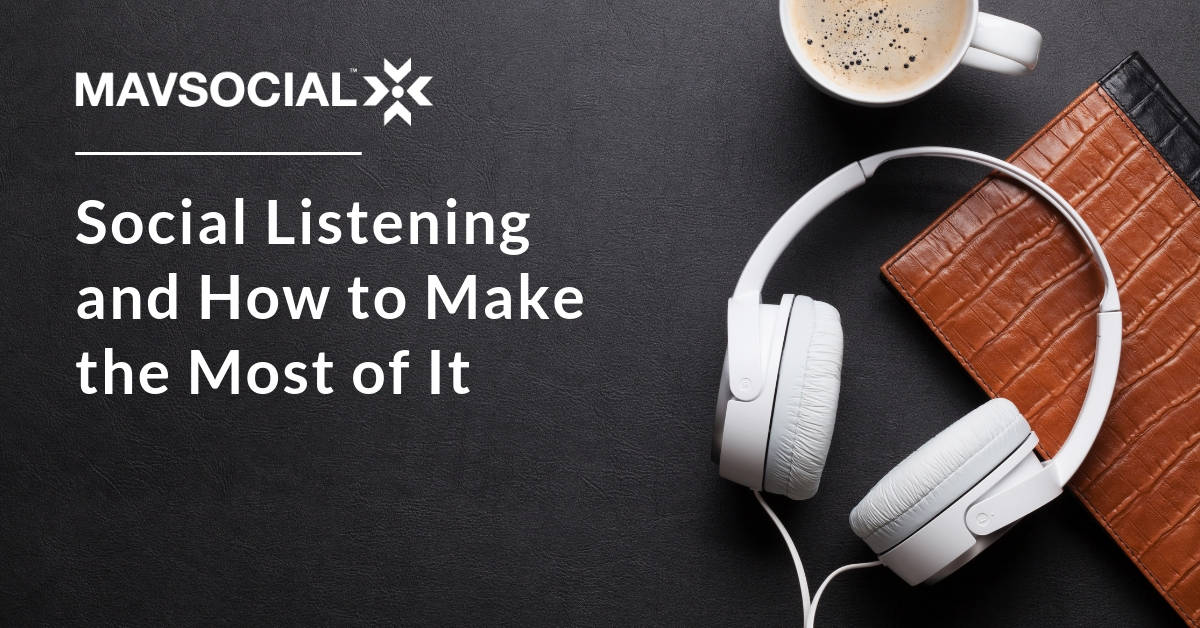Your customers and those of your biggest competitors are talking about trends and your brand on social media.
Unless you’re listening, you are missing out on one of the biggest opportunities to understand your customer and the industry.
This is where social listening takes center stage.
Social Monitoring and Social Listening – Connected but Different
Social monitoring and social listening are often confused.
The two are similar but they have key differences.
Social monitoring is the process of collecting engagements directed at your brand on social media.
It allows businesses to respond to individual brand and product issues.
Social media listening entails compiling keywords, terms, and hashtags on topics of interest or even competitors.
Organizations oftentimes use the aggregated information to understand sentiments, trends and customer needs in their industry.
Social listening combined with social monitoring and analytics produces valuable business insights.
It reveals the trends and broader issues in the industry, enabling businesses to fix underlying issues or meet specific needs.
It can also help to highlight important business opportunities.
When you use social listening, the accumulated information that you acquire offers broader insights that social media monitoring would miss.
By using the trends and sentiments expressed on social media, businesses are able to develop agile marketing and business strategies in response to customer needs.
How You Can Use Social Listening and Monitoring to Boost Your Business
Listening and monitoring your audience can give you an opportunity to hear the truth straight from the horse’s mouth.
It offers a bird’s eye view into what is happening in the industry, and helpful information about market reaction to competitor products.
Monitor your brand
When you understand exactly what your customers are saying about your brand you can design your entire product proposition to their exacting requirements.
In modern business, the consumer defines your product.
Marketers monitor their brands by keeping track and responding to mentions, replies or direct messages on social media.
Brand popularity can then be measured against the overall sentiment in the industry using social listening.
Improve your customer service
By responding to questions and compliments you can retain loyal customers and attract new ones.
According to a Sprout Survey, 83% of customers preferred brands that engaged with them.
When you help people to overcome problems and quickly respond to customer complaints you show them that your company cares.
Thanking them for compliments and positive feedback is just as important.
According to research carried out with Bain and Company, customers spent 40% more with the businesses that engaged with them on social media.
Competitor analysis
Know what your competitors’ customers are saying about them by tracking your competitors.
Understand the threats and opportunities in the industry and learn from your opposition.
Learning from the mistakes of others is a lot less painful than learning from your own.
Social listening allows you to benchmark your product proposition against those of your competitors.
When you listen in on the social media discussions of your competitor’s customers you can obtain important intelligence into what they are doing and where you fit in the marketplace.
Design and Manage your Marketing Campaigns
Listening can help you create as well as understand the success of your marketing campaigns.
Once launched it is useful for gauging the reaction.
If the public does not react well to your latest campaign you can take quick action to correct the situation.
If it’s a hit you can capitalize on it.
Understand what engages your audience and use the information for future campaigns.
Product Development
Use social listening to understand what your customers want, what products or services to develop and what to change.
This can form an important basis for your product development team.
Extend Your Reach
Use insights gained from listening to build content that provides value and be ahead of the game.
In this way, you can attract content viewers to your brand.
Knowing which content is favored on each of the social media channels can help you develop your content strategy.
It is much easier to attract new customers that already know your brand through the content that they follow than to captivate a new and unknown audience.
Attract Social Influencers
Find potential ambassadors for your brand.
You may already have a number of micro-influencers promoting your brand out there.
Unless you’re listening you’ll never know about them.
Find them and thank them for their support.
Crisis Management
Social media has its disadvantages too.
Rumors and the frustrations of customers can cause reputational damage to your brand.
When you become aware that negative sentiment is developing you can quickly avoid a crisis before it intensifies.
This allows you to efficiently manage your online reputation.
Using These Powerful Tools
Social listening tools such as MavSocial’s can be used to keep track of what is happening on several social media accounts at once.
They use keywords and topics to pick up all mentions of your brand, product or topic.
The information is aggregated in a single place.
This data can be used to drive your marketing and business decisions.
Getting Started
There are six simple steps to getting started with social listening.
- Identify your goals so you know what conversations to track
- Identify the social media platforms that you plan to monitor
- Choose the tool that will give you the data you will need
- Watch the competition
- Respond to customers
- Act on your insights!
Understanding Your Customer
Social listening is about understanding the sentiments and expectations of your customers.
When your business moves use social media monitoring and listening, the aggregated information informs all of your business decisions.
It’s forward-looking and it offers businesses social media intelligence that when effectively used, will improve brand management and boost the bottom line.
